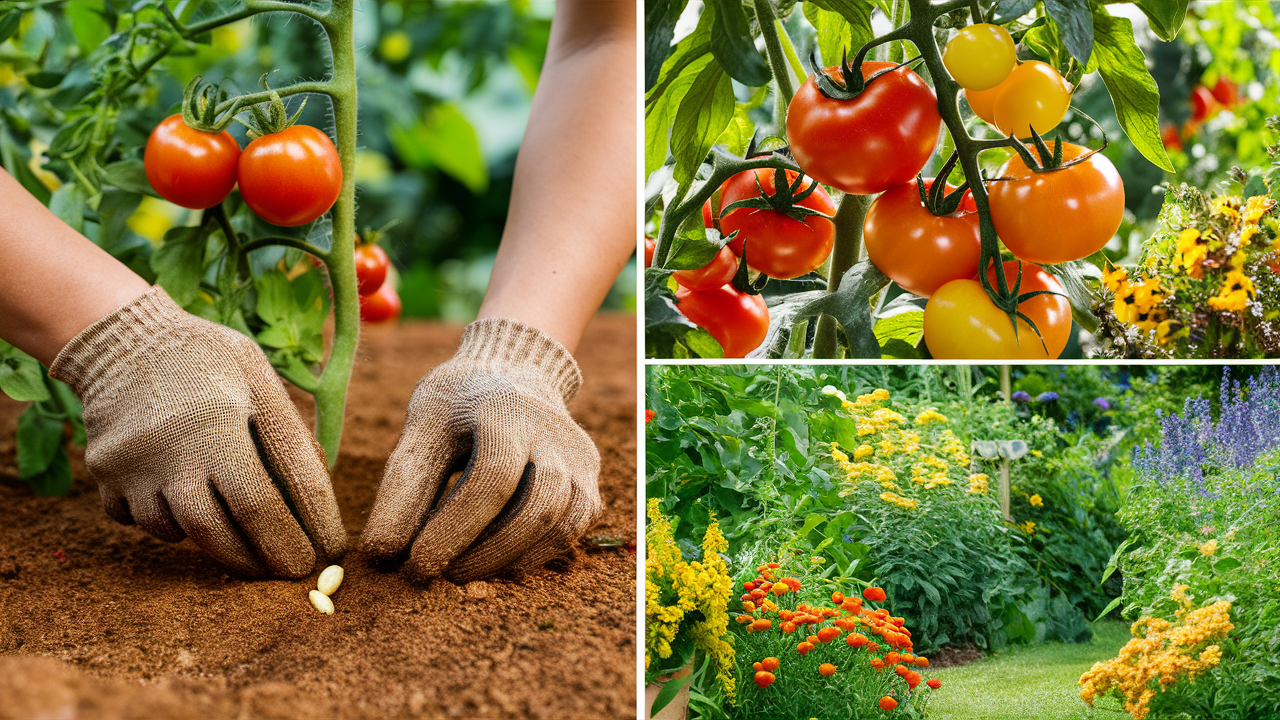Certainly! Welcome to our comprehensive guide to Plant Tomatoes in your home garden. Whether you’re a seasoned gardener or a beginner, this article covers everything you need to know—from choosing the right location and soil to mastering watering techniques and pest management. We’ll explore topics like companion planting, sustainability practices, and even the aesthetics of tomato gardening. Let’s dive in and cultivate those juicy, homegrown tomatoes! 🍅🌿🌱
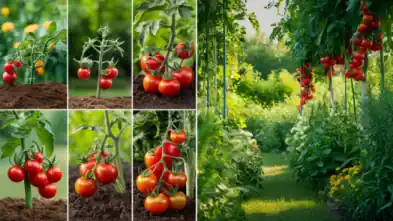
1. Location and Space
Assess Space:
- Understanding Room Requirements: Tomatoes need enough space to grow without crowding each other. Consider the mature size of the tomato variety you’re planting. Some determinate varieties stay compact, while indeterminate ones can sprawl.
- Spacing Guidelines: Aim for 18-36 inches between tomato plants. This spacing allows proper airflow, reduces disease risk, and prevents overcrowding.
- Companion Plants: If you’re growing other vegetables nearby, ensure they won’t compete for space with your tomatoes. Companion plants like basil or marigolds can also help deter pests.
Vertical Gardening:
- Space-Saving Techniques: Vertical gardening involves growing plants upward instead of outward.
- Trellises or Stakes: Install sturdy trellises or stakes near your tomato plants. As the tomatoes grow, guide their vines upward. This method saves ground space and keeps the fruit off the soil.
- Benefits of Vertical Growth:
- Sunlight Exposure: Vertical positioning ensures better sunlight access for leaves and fruit.
- Ease of Harvesting: You can easily pick ripe tomatoes without bending down.
- Improved Air Circulation: Proper airflow reduces the risk of fungal diseases.
🌞 Sunlight Requirements for Tomatoes
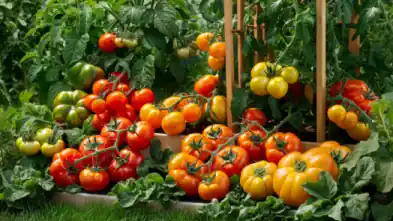
Full Sun:
- Ideal: Tomatoes thrive in full sun, which means they need at least 6-8 hours of direct sunlight daily.
- Benefits:
- Robust growth.
- Maximum fruit production.
- Enhanced flavor.
Partial Shade:
- Considerations: If full sun isn’t possible, aim for 4-6 hours of sunlight.
- Effects:
- Slower growth.
- Fewer fruits.
- Less intense flavor.
Full Shade:
- Caution: Tomatoes struggle in full shade.
- Outcome:
- Weak plants.
- Sparse fruiting.
- Blander taste.
🌱 Soil Conditions to Plant Tomatoes

- Soil Types:
- Sandy Soil: Light and well-draining. Mix in organic matter to improve water retention.
- Loamy Soil: Ideal for tomatoes—balanced texture with good drainage and moisture retention.
- Clayey Soil: Heavy and compact. Amend with sand and organic material to enhance drainage.
- pH Adjustment:
- Acidic Soil (pH < 7): Tomatoes prefer slightly acidic soil (around pH 6.2-6.8).
- Alkaline Soil (pH > 7): Adjust pH using amendments (sulfur for acidity, lime for alkalinity).
Remember, healthy soil sets the stage for thriving tomato plants! 🍅🌿🌱 :
🌦️ Climate and Microclimates to Plant Tomatoes
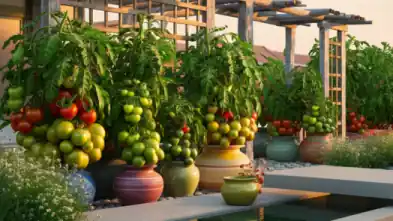
- Local Insights:
- Research Your Area: Understand your local climate. Consider factors like average temperatures, frost dates, and humidity levels.
- Microclimates: Identify microclimates within your garden. Some spots may be warmer or cooler due to nearby structures, trees, or water features.
- Climate Modifications:
- Greenhouse Gardening: Use a greenhouse to create a controlled environment for tomatoes.
- Benefits:
- Extended growing season.
- Protection from extreme weather.
- Consistent temperature and humidity.
- Benefits:
- Indoor Growing:
- Grow Lights: Indoors, use grow lights to mimic sunlight.
- Containers: Plant tomatoes in pots or containers.
- Temperature Control: Maintain a stable indoor temperature.
- Greenhouse Gardening: Use a greenhouse to create a controlled environment for tomatoes.
Remember, adapting to your specific climate ensures successful tomato cultivation! 🍅🌿🌱 :
- Temperature:
- Optimal Range: Tomatoes thrive in temperatures between 21°C and 24°C (70°F to 75°F).
- Desirable Range: Avoid temperatures below 16°C (60°F) and above 27°C (80°F).
- Germination: For seed germination, the minimum required temperature is 8-10°C (46-50°F), with an optimum range of 16-29.5°C (61-85°F).
- Sunlight:
- Full Sun: Tomatoes need at least 6-8 hours of direct sunlight daily for robust growth and fruit production.
- Rainfall:
- Low to Medium: Tomato plants prefer moderate rainfall.
- Avoid Frost: They do not withstand frost.
- Soil pH:
- Slightly Acidic: Aim for a soil pH of 6.2 to 6.8 for optimal tomato growth.
🌱 Planting Methods for Tomatoes: Ratings and Reasons
| Title | Rating | Reason | Expenses | Indoor | Outdoor | Fruit Growth | Maintenance Input | Conclusion |
|---|---|---|---|---|---|---|---|---|
| Seeds vs. Transplants | Both | Seeds: Cost-effective, wider variety. Transplants: Convenient, faster start (requires purchasing). | Moderate | Yes | Yes | High | Moderate | Choose based on time, budget, and preference. |
| Aquaponics | High | Efficient nutrient cycling (fish waste), water conservation. | High | Yes | Yes | High | Low | Ideal for sustainable, controlled growth. |
| Back to Eden Gardening | Moderate | Moisture retention, weed suppression, gradual nutrient release. | Low | Yes | Yes | Moderate | Low | Good for soil health and low-cost gardening. |
| Biodynamic Gardening | Moderate | Holistic approach, composting enhances soil health. | Low | Yes | Yes | Moderate | Low | Aligns with natural rhythms and ecosystem. |
| Companion Planting | Moderate | Pest control (some plants repel insects), improved growth through synergy. | Low | Yes | Yes | Moderate | Low | Enhances biodiversity and reduces pests. |
| Raised Bed Gardening | High | Better drainage, soil quality control, elevated planting areas. | Moderate | Yes | Yes | High | Moderate | Efficient use of space and improved soil. |
| Container Gardening | Moderate | Flexibility (ideal for small spaces), requires proper container selection. | Low | Yes | Yes | Moderate | Low | Great for balconies or limited areas. |
| Square Foot Gardening | High | Efficient use of space, organized layout. | Low | Yes | Yes | High | Low | Maximizes yield per square foot. |
| Hydroponic Gardening | High | Precise nutrient delivery, controlled environment. | High | Yes | Yes | High | Low | Ideal for urban gardening and year-round growth. |
| Hügelkultur | Moderate | Soil fertility improvement, water retention. | Low | Yes | Yes | Moderate | Low | Uses wood-based mounds for sustainable growth. |
| Traditional Inground Gardening | Moderate | Classic method, requires good soil preparation. | Low | Yes | Yes | Moderate | Moderate | Common and straightforward approach. |
| Vertical Gardening | Moderate | Space-efficient, maximizes sunlight exposure. | Low | Yes | Yes | Moderate | Low | Great for small spaces and aesthetics. |
| Edible Landscaping | Low | Aesthetic focus, less yield per area. | Low | Yes | Yes | Low | Low | Blends food plants into overall landscape. |
| Window Box Gardening | Low | Limited space, decorative rather than high yield. | Low | Yes | Yes | Low | Low | Adds beauty but not ideal for large harvests. |
| Lasagna Gardening | Moderate | No-dig approach, organic material layers. | Low | Yes | Yes | Moderate | Low | Uses layering for soil enrichment. |
| Straw Bale Gardening | Moderate | Simplicity, compostability. | Low | Yes | Yes | Moderate | Low | Easy and eco-friendly method. |
| No Till Gardening | High | Minimal soil disturbance, weed-free, natural growth. | Low | Yes | Yes | High | Low | Reduces soil disruption and promotes healthy soil. |
🌿 Seasonal Considerations for Tomato Plants

- Fruit and Flower Times:
- Timeline: Depending on the variety, tomato plants can bear fruit two to three weeks after the flowers fully open.
- Early Varieties: Some early types yield ripe fruit as early as 50 days from planting.
- Average Range: Most tomatoes take between 60 and 100 days from sowing to harvest12.
- Signs:
- Flowers emerge and bloom.
- Pollination occurs.
- Small, hard green tomato fruits form.
- Fruits rapidly expand to full size.
- Tomatoes begin ripening.
- Fully ripe and ready for picking.
- Extending the Season:
- Cold Frames: Use cold frames to protect young tomato plants from frost and extend the growing season.
- Benefits:
- Warmer environment.
- Earlier planting.
- Frost protection.
- Benefits:
- Indoor Gardening:
- Grow Lights: Indoors, use grow lights to mimic sunlight.
- Containers: Plant tomatoes in pots.
- Temperature Control: Maintain stable indoor temperatures.
- Cold Frames: Use cold frames to protect young tomato plants from frost and extend the growing season.
Remember, understanding tomato growth stages and adjusting conditions can lead to a fruitful harvest! 🍅🌿🌱 :
🌼 Companion Planting for Tomatoes: The Buddy System
- Pairing Compatible Plants:
- Why?: Companion planting enhances tomato growth and deters pests.
- Examples:
- Basil: Plant basil near tomatoes to improve flavor and repel insects.
- Marigolds: These flowers deter nematodes and attract beneficial insects.
- Chives: Chives protect tomatoes from aphids.
- Nasturtiums: These edible flowers repel pests and add color to your garden.
Remember, a well-chosen companion can be a tomato plant’s best friend! 🍅🌿🌱.
🐞 Pest Management for Tomato Plants: Natural Solutions
- Cutworms:
- Description: Caterpillars of various moth species.
- Signs of Damage: They cut down young tomato plants and eat leaves.
- Control:
- Hand-pick small caterpillars.
- Use pheromone traps for adults.
- Maintain weed control to eliminate daytime hiding spots.
- Hornworms:
- Description: Large caterpillars with a horn-like tail.
- Signs of Damage: Voracious eaters—consume tomato leaves rapidly.
- Control:
- Hand-pick when small.
- Encourage braconid wasps (natural predators).
- Aphids:
- Description: Soft-bodied, light to dark-green insects.
- Signs of Damage: Hide on leaf undersides, reproduce rapidly.
- Control:
- Spray with a strong stream of water to dislodge.
- Use soapy water spray.
- Introduce ladybugs for natural control.
- Neem Oil:
- Natural Pesticide: Spray on leaves to prevent and treat leaf problems.
- Effective Against: Various pests, including aphids.
Remember, a little natural intervention goes a long way in protecting your tomato plants! 🍅🌿🌱.
🚿 Watering and Drainage to Plant Tomatoes
- Water Wisely:
- Understanding Water Needs:
- Tomatoes need consistent moisture to grow and thrive.
- Overwatering can lead to root rot, while underwatering affects nutrient absorption.
- Best Practices:
- Water deeply but infrequently.
- Soak the soil to a depth of at least 6 inches.
- Water at the base, avoiding wetting the foliage.
- Use a drip irrigation system for efficient watering.
- Understanding Water Needs:
- Drainage Matters:
- Importance:
- Proper drainage prevents waterlogged soil.
- Soggy soil can harm tomato roots.
- Tips:
- Choose well-draining soil.
- Ensure pots have sufficient drainage holes.
- Elevate containers to improve airflow.
- Avoid overwatering.
- Importance:
Remember, balanced watering and good drainage lead to healthy tomato plants! 🍅🌿🌱.
🌱 Weeding and Maintenance for Tomato Plants
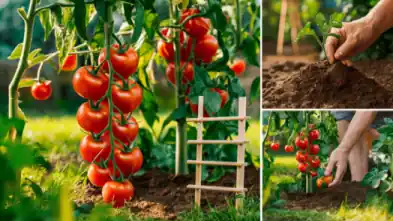
- Tidy Garden:
- Why Weed?: Weeds compete with tomatoes for nutrients, water, and sunlight.
- Best Practices:
- Regularly inspect your garden.
- Pull out weeds by the roots.
- Mulch around tomato plants to suppress weed growth.
- Pruning Tips:
- Why Prune?: Pruning encourages airflow, reduces disease risk, and directs energy to fruit production.
- When to Prune:
- Remove suckers (side shoots) when they’re small.
- Trim yellowing or damaged leaves.
- Deadhead (remove spent flowers) to redirect energy.
Remember, a well-maintained garden yields healthy, productive tomatoes! 🍅🌿🌱.
🍅 Harvesting Techniques for Tomato Plants
- Peak Flavor:
- Timing: Harvest tomatoes when they reach full color (varies by variety).
- Signs of Ripeness:
- Firmness: Gently squeeze—the fruit should yield slightly.
- Color: Red, orange, or yellow, depending on the type.
- Easy Detachment: Twist gently—ripe tomatoes come off easily.
- Reasons: Peak flavor and optimal sweetness.
- Continuous Harvest:
- How It Works:
- Tomatoes can be harvested repeatedly throughout the season.
- As new fruits ripen, pick them regularly.
- Benefits:
- Encourages more fruit production.
- Keeps plants healthy.
- Maximizes yield.
- How It Works:
- Drainage Matters:
- Importance: Proper drainage is crucial to prevent root rot in tomato plants.
- Recommendations:
- Assess Soil: Check your garden soil. If it’s heavy and clay-like, it retains too much water, which can suffocate roots.
- Amend Soil: Improve drainage by adding organic matter like compost, peat moss, or well-rotted manure. These enhance soil structure and drainage capabilities1.
- Fertilize Right with Organic Options:
- Organic Fertilizers: Opt for natural and environmentally friendly options.
- Examples:
- Espoma Tomato-Tone Organic Fertilizer (3-4-6): Contains bone meal, feather meal, and other natural ingredients. Enhances tomato flavor, promotes healthy growth, and provides long-lasting results2.
- Legumes: Consider planting legumes (peas, beans, clover) after tomatoes. Their root systems restore nitrogen to the soil, benefiting subsequent crops3.
- Crop Rotation:
- Why Rotate Crops:
- Soil Health: Prevent soil depletion by alternating crops.
- Disease Prevention: Disrupt disease cycles and reduce the risk of soil-borne pathogens.
- Ideal Rotation:
- Why Rotate Crops:
Remember, these practices contribute to healthier tomato plants and better yields! 🍅🌿🌱.
🌼 Aesthetic Appeal for Tomato Plants
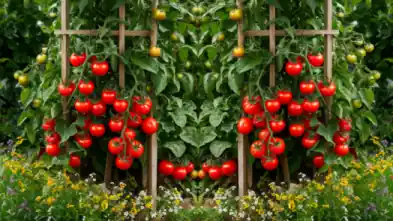
- Visual Impact:
- Arrangement: Group tomato plants strategically for visual appeal.
- Trimming:
- Pruning: Remove excess foliage to improve airflow and showcase fruit clusters.
- Deadheading: Trim off yellowing leaves and spent flowers.
- Staking or Trellising: Keep tomato vines upright for a neat appearance.
- Colors and Textures:
- Variety: Plant different tomato varieties with varying colors (red, yellow, orange, green).
- Texture Contrast:
- Mix smooth-skinned tomatoes (like Roma) with ribbed or wrinkled ones (like heirlooms).
- Consider companion plants with contrasting foliage (e.g., basil or marigolds).
Remember, a well-designed tomato garden is both productive and visually delightful! 🍅🌿🌱.
🌿 Sustainability Practices to Plant Tomatoes
- Chemical-Free:
- Organic Methods:
- Avoid synthetic pesticides and fertilizers.
- Use natural alternatives like neem oil or garlic spray.
- Focus on soil health through composting and organic matter.
- Organic Methods:
- Beneficial Insects:
- Pollinators:
- Attract bees, butterflies, and other pollinators to your garden.
- Plant flowers nearby (marigolds, zinnias) to encourage visits.
- Healthy pollination leads to better fruit set in tomatoes.
- Pollinators:
Remember, sustainable practices benefit both your garden and the environment! 🍅🌿🌱.
🌱 Disease Prevention for Tomato Plants: Spacing Matters
- Why Proper Spacing?:
- Air Circulation: Adequate spacing allows air to flow freely between tomato plants.
- Reduced Fungal Risk: Good airflow minimizes the risk of fungal diseases like early blight and powdery mildew.
- Prevents Crowding: Spaced-out plants avoid competing for nutrients, water, and sunlight.
Remember, giving your tomatoes room to breathe keeps them healthy and disease-resistant! 🍅🌿🌱.
🌦️ Adaptability to Changes to Plant Tomatoes
- Weather Preparedness:
- Fluctuations: Be aware of changing weather conditions.
- Preparation:
- Cover plants during unexpected frost.
- Shield from extreme heatwaves with shade cloth or mulch.
- Extreme Conditions:
- Frost Protection:
- Cover: Use blankets, cloths, or frost cloth to shield plants.
- Watering: Wet soil retains heat better.
- Heatwaves:
- Shade: Provide shade during scorching days.
- Hydration: Water deeply to prevent wilting.
- Frost Protection:
Remember, adaptability ensures your tomato plants thrive in any weather! 🍅🌿🌱.
🌱 Container vs. Ground Planting to Plant Tomatoes

- Container Gardening:
- Advantages:
- Flexibility: Ideal for small spaces, balconies, or patios.
- Mobility: Move containers to optimize sunlight exposure.
- Weed Control: Less chance of weeds.
- Considerations:
- Container Size: Choose large pots (at least 5 gallons) for healthy root growth.
- Quality Soil: Use well-draining potting mix.
- Watering: Containers dry out faster—water consistently.
- Advantages:
- Ground Planting:
- Classic Plot:
- Directly plant tomatoes in the ground.
- Advantages:
- Natural Environment: Mimics their native habitat.
- Root Space: Unlimited root expansion.
- Nutrient Access: Direct access to soil nutrients.
- Considerations:
- Soil Preparation: Amend soil with organic matter.
- Spacing: Allow enough room between plants.
- Weeding: Regularly weed to reduce competition.
- Classic Plot:
Remember, choose the method that suits your space, resources, and gardening style! 🍅🌿🌱.
CONCLUSION
Certainly! In summary, successful tomato gardening involves a thoughtful blend of science and art. From choosing the right location and soil to understanding seasonal considerations, we’ve explored essential factors. Remember to maintain proper spacing, encourage beneficial insects, and adapt to changing weather. Whether you’re growing tomatoes in containers or directly in the ground, prioritize sustainability and aesthetics. Happy gardening! 🍅🌿🌱

